Chromatin Modulatory Proteins and Olfactory Receptor Signaling in the Refinement and Maintenance of Fruitless Expression in Olfactory Receptor Neurons
- PMID: 27093619
- PMCID: PMC4836687
- DOI: 10.1371/journal.pbio.1002443
Chromatin Modulatory Proteins and Olfactory Receptor Signaling in the Refinement and Maintenance of Fruitless Expression in Olfactory Receptor Neurons
Abstract
During development, sensory neurons must choose identities that allow them to detect specific signals and connect with appropriate target neurons. Ultimately, these sensory neurons will successfully integrate into appropriate neural circuits to generate defined motor outputs, or behavior. This integration requires a developmental coordination between the identity of the neuron and the identity of the circuit. The mechanisms that underlie this coordination are currently unknown. Here, we describe two modes of regulation that coordinate the sensory identities of Drosophila melanogaster olfactory receptor neurons (ORNs) involved in sex-specific behaviors with the sex-specific behavioral circuit identity marker fruitless (fru). The first mode involves a developmental program that coordinately restricts to appropriate ORNs the expression of fru and two olfactory receptors (Or47b and Ir84a) involved in sex-specific behaviors. This regulation requires the chromatin modulatory protein Alhambra (Alh). The second mode relies on the signaling from the olfactory receptors through CamK and histone acetyl transferase p300/CBP to maintain ORN-specific fru expression. Our results highlight two feed-forward regulatory mechanisms with both developmentally hardwired and olfactory receptor activity-dependent components that establish and maintain fru expression in ORNs. Such a dual mechanism of fru regulation in ORNs might be a trait of neurons driving plastic aspects of sex-specific behaviors.
Conflict of interest statement
The authors have declared that no competing interests exist.
Figures
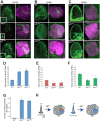


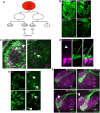

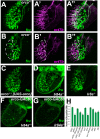
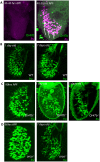

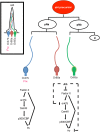
Similar articles
-
Distinct Roles and Synergistic Function of FruM Isoforms in Drosophila Olfactory Receptor Neurons.Cell Rep. 2020 Dec 15;33(11):108516. doi: 10.1016/j.celrep.2020.108516. Cell Rep. 2020. PMID: 33326795 Free PMC article.
-
Social Context Enhances Hormonal Modulation of Pheromone Detection in Drosophila.Curr Biol. 2019 Nov 18;29(22):3887-3898.e4. doi: 10.1016/j.cub.2019.09.045. Epub 2019 Oct 31. Curr Biol. 2019. PMID: 31679932 Free PMC article.
-
Neurogenetics of courtship and mating in Drosophila.Adv Genet. 2008;62:67-184. doi: 10.1016/S0065-2660(08)00603-2. Adv Genet. 2008. PMID: 19010254 Review.
-
Neurons That Underlie Drosophila melanogaster Reproductive Behaviors: Detection of a Large Male-Bias in Gene Expression in fruitless-Expressing Neurons.G3 (Bethesda). 2016 Aug 9;6(8):2455-65. doi: 10.1534/g3.115.019265. G3 (Bethesda). 2016. PMID: 27247289 Free PMC article.
-
What does the fruitless gene tell us about nature vs. nurture in the sex life of Drosophila?Fly (Austin). 2017 Apr 3;11(2):139-147. doi: 10.1080/19336934.2016.1263778. Epub 2016 Nov 23. Fly (Austin). 2017. PMID: 27880074 Free PMC article. Review.
Cited by
-
Preparing Developing Peripheral Olfactory Tissue for Molecular and Immunohistochemical Analysis in Drosophila.J Vis Exp. 2018 Jun 13;(136):57716. doi: 10.3791/57716. J Vis Exp. 2018. PMID: 29985372 Free PMC article.
-
Alternative strategies based on transgenic Drosophila melanogaster for the functional characterization of insect Ionotropic Receptors.Biol Res. 2025 Jun 9;58(1):36. doi: 10.1186/s40659-025-00619-0. Biol Res. 2025. PMID: 40490823 Free PMC article.
-
Sex Mysteries of the Fly Courtship Master Regulator Fruitless.Front Behav Neurosci. 2019 Oct 18;13:245. doi: 10.3389/fnbeh.2019.00245. eCollection 2019. Front Behav Neurosci. 2019. PMID: 31680899 Free PMC article. Review.
-
Social experience and pheromone receptor activity reprogram gene expression in sensory neurons.G3 (Bethesda). 2023 Jun 1;13(6):jkad072. doi: 10.1093/g3journal/jkad072. G3 (Bethesda). 2023. PMID: 36972331 Free PMC article.
-
Mechanisms controlling diversification of olfactory sensory neuron classes.Cell Mol Life Sci. 2017 Sep;74(18):3263-3274. doi: 10.1007/s00018-017-2512-2. Epub 2017 Mar 29. Cell Mol Life Sci. 2017. PMID: 28357469 Free PMC article. Review.
References
-
- Goodwin SF, Taylor BJ, Villella A, Foss M, Ryner LC, Baker BS, et al. Aberrant Splicing and Altered Spatial Expression Patterns in fruitless Mutants of Drosophila melanogaster. Genetics. 2000;154: 725–745. http://www.genetics.org/content/154/2/725.short - PMC - PubMed
-
- Anand A, Villella A, Ryner LC, Carlo T, Goodwin SF, Song HJ, et al. Molecular genetic dissection of the sex-specific and vital functions of the Drosophila melanogaster sex determination gene fruitless. Genetics. 2001;158: 1569–95. http://www.pubmedcentral.nih.gov/articlerender.fcgi?artid=1461753&tool=p... - PMC - PubMed
Publication types
MeSH terms
Substances
LinkOut - more resources
Full Text Sources
Other Literature Sources
Molecular Biology Databases
Miscellaneous

